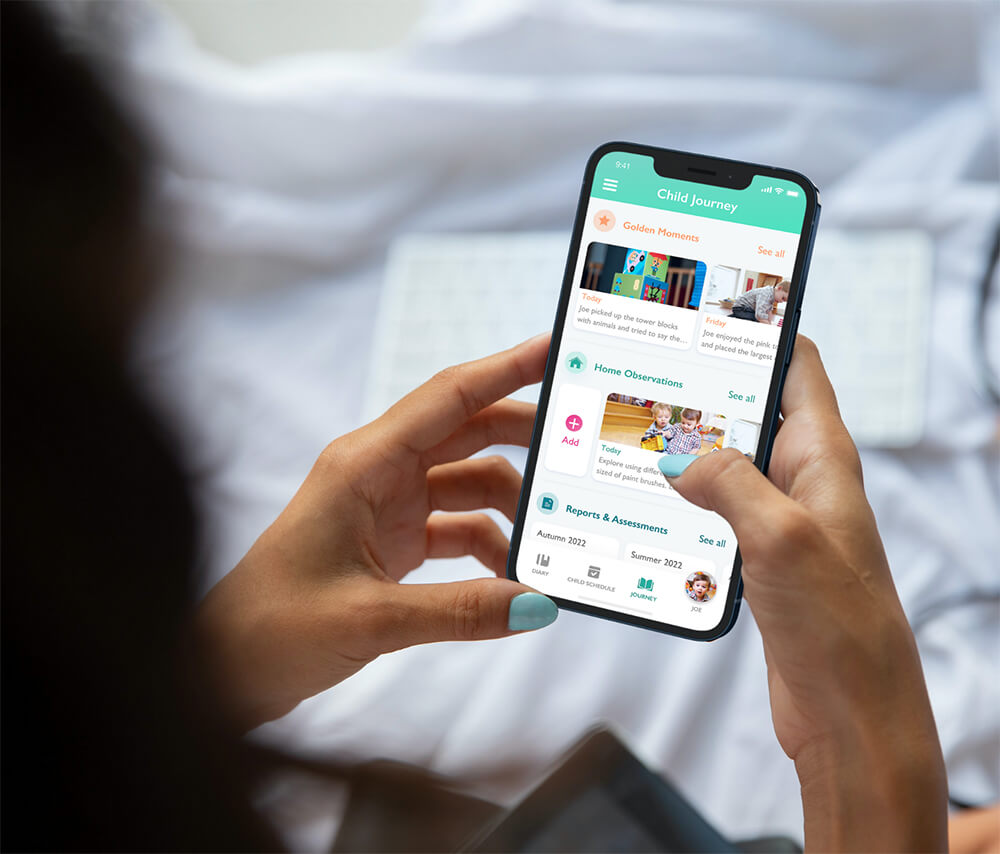Nursery is the place where many firsts are experienced: first friends, first words and first steps. It can be a daunting time for children and their parents and requires careful organisation to ensure a smooth transition is achieved.
Having a well-prepared new starter procedure can help children settle in quicker, reduce parental anxiety and allow smooth sailing for your staff. In this article, we share the ultimate 10-step guide for settling in new children (and their parents) to your Early Years setting.
Why are parents anxious about their child starting nursery?
Parents want their children to be happy, healthy, and safe at all times; this responsibility has been theirs alone until now. When a child begins nursery for the first time, parents are handing that responsibility to you and your staff. Understandably, there may be some worries that accompany this big milestone in their child’s life.
Parents’ main concerns often centre around people, environment, and routines. Your nursery team must be prepared to effectively support the children and parents through the transition into your Early Years setting.
New starters may be new to nursery entirely or moving from another childcare provider. The settling-in process remains consistent to ensure a positive start to their Early Years journey with you and your team.
How can your staff help to settle new children starting nursery into your Early Years setting?
Consistency gives confidence to parents
All parents need to be given the same information from your communication platform as well as from the staff themselves. Once a term, run a staff meeting that focuses on the new starter process and explain to all team members what their role is throughout the process, even if the child isn’t in their assigned room.
Supporting - but not enforcing - 'parent guilt'
Parents may feel ‘parent guilt’ for leaving their child during the day (especially those just finishing maternity or paternity leave) and may require a little extra empathy from your staff. Remind staff that a little goes a long way when supporting particularly anxious parents.
An extra message or photo shared to their child’s diary on the communication app can allay worries that their child isn’t settled and enjoying their nursery day.
Confidence their child is in the best hands
Fill the parents with the confidence they seek that their little one will be loved, supported, and nurtured in every way they need. Reassurance can come from positive body language, a smiley face and confident interaction with the children.
10 steps to settle in new children (and parents) starting nursery at your setting
1. Communication is key for new parents
The first (and arguably most important) step for settling in new children and parents to your setting is to ensure clear communication is a priority from the very beginning. Parents must be aware of logistical details such as pick-up and drop-off times, and items to bring to the nursery on their first day.
Effective use of communication platforms and nursery management software allows parents to find all statutory information, including the policies and procedures all nurseries must have. Having this information can reduce parental anxieties due to knowing what to expect.
Make sure your parents know all information for the transition period; first-time parents may not know to be flexible during the settling-in period, often short days can be introduced initially to help with a smooth transition before taking the leap to full days.
2. Information collection
You and your team will gain information on the new starter’s likes, dislikes, favourite Pokémon, and all other important details as your relationship grows. Knowing information about a new child isn’t just needed to ensure they have a good day; it is a safety precaution and is a vital step in settling in.
Step two in the process fits hand in hand with communication. Use your nursery management software to gather all information possible from the parent right at the start of their journey: it can support a smooth transition.
Many nurseries use paper ‘all about me’ booklets for the parents to complete on a short-stay day, gathering information on home structure, allergies, medicines used, and routines. Ultimately, the most effective method is an online system, where information can be shared with all team members ensuring nursery-wide coverage.

3. Stay and play transition
Most settings organise a stay-and-play structure for a gradual transition for new starters, where parents will attend the nursery with their child and begin to build up their independence and comfortability in the setting before leaving.
As all children adjust to a new setting differently, the length of time this phasing transition lasts depends on the comfortability of both the child and the parent. Introducing the child’s key worker in a play situation with the security of parent support nearby can begin to build trust and start the foundations of a positive relationship.
4. Build Key Worker relationships
The staff member assigned to a child may stay their person for the entirety of the child’s nursery journey. Having a positive working relationship is essential for the child to feel supported and comfortable to take measured risks and try new things. Begin their nursery journey with plenty of exciting activities the child can complete with their key workers, creating positive golden moments to develop a trusting relationship.
5. Keep in touch with nursery management software
Picture the scene: it’s drop-off time, and a child is struggling to leave their parent. There are tears and cries; the parent eventually drags themself off to work, feeling rotten. What most parents aren’t aware of is how quickly that child will settle once they are immersed into their nursery routine.
The parent may spend their whole working day worrying that their child is hysterically crying and miserable when they are actually helping to collect the eggs from the resident chickens, exploring the noises empty containers make, and socialising with their new friends.
Therefore, remember to share these positive images in the child’s online learning diary. The parent can relax, secure in the knowledge that their child is happy and enjoying their day.
6. Environment familiarisation
You will have already converted your walkaround parents into clients, choosing your nursery as the right setting for them. A recap of the main areas can also be appreciated by parents in the first few days of their child starting. The environment familiarisation for the child is a longer process.
First, begin by showing all of the exciting and important areas of the room they will spend time in: the toilets, outdoor area, role play area, and where pick-up and drop-off will take place.
One of the largest parent worries for new starters is their child getting lost going to the toilet; use sticker dots on the walls or floors to help new starters find the toilet easily in their first few weeks in the toddler rooms.

7. Maintain routines with new children
All the relevant information will have been collected via your communication platform, including their feeding, toileting and sleeping routines. Children are remarkably resilient and can adapt to new routines quickly.
However, keeping routines as similar as possible will help keep disruption to a minimum during the daytime and once they are at home. You can display your usual routines on your website for parents or try sharing their daily timetable on your Blossom Parent App to give parents a window into their day at nursery.

8. Social demand awareness
Nursery is an exciting new environment to explore, with different toys and games to play, new friends to interact with and lots of learning to enjoy. The nursery setting, for some, can be a large jump socially, especially for those babies born during lockdown. Remind your staff to be mindful of the social demand hot spots of the day; these will be heavily social times or activities.
By organising some quiet activity alternatives with reduced social interaction, children can gradually build their tolerance to social interaction without feeling overwhelmed. Focus on creating inclusive learning opportunities for all diversities of children.
9. Monitor progress for new starters
Children can typically take between 2-4 weeks to settle into nursery. There are several additional factors that can help or hinder the rate the child settles into their new nursery routine: the number of days they attend, the comfortability of the parents and their own personalities and confidence levels.
Use an online system to track the settling-in progression and highlight any early concerns. It may be highlighted that a child struggles with the morning drop-off each time, and current strategies don’t seem to be working effectively, causing the child (and parent) to feel distressed.
As the progress will be easily tracked on the online system, it will be simple to monitor the success of new strategies implemented and share them across the whole staff team.
10. Celebrate achievement and success
Moving into nursery school is a big step (for children and parents); many milestones are achieved during this vital development time. Use your online communication platform effectively by sharing and celebrating these golden moments with the parents on a secure platform.
Joining a nursery is a big step for children and their parents; most will skip through the door without a backwards glance but there may be some who find the transition more challenging.
This 10-step guide supports new starters across all levels of confidence and comfortability. Share this guide with your nursery team during your next staff meeting to give your new starters (and your staff) the smoothest start possible.
